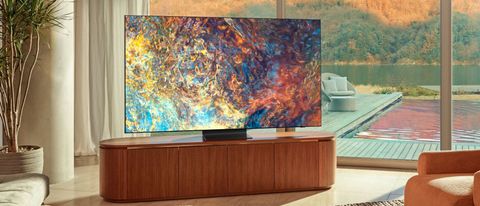TechRadar Verdict
The Samsung QN90A is thinner, brighter and bolder than previous high-end LCD TVs, offering a high peak brightness and fantastic contrast. Its thinner body comes with a few caveats in the form of thinner sound and a higher center of gravity, and it only sports one full spec HDMI 2.1 port. Its fantastic picture quality makes it a massively appealing choice, especially after some price cuts.
Pros
- +
Extreme brightness
- +
Exquisite color saturation
- +
Powerful upscaling
- +
Eco-friendly remote
Cons
- -
Pedestal stand is wobbly
- -
No OneConnect Box
- -
No Dolby Vision support
- -
Mediocre sound quality
Why you can trust TechRadar
One-minute review
The Samsung QN90A Neo QLED was one of the first screens in 2021 to use the company’s hyped-up Neo QLED panels that sport a higher count of light emitting diodes per square inch than previous generations. The result was a brighter TV than its predecessors and one that can display a deeply satisfying array of colors.
Since its release in 2021, we've seen some newer QLED TVs that use Shape Adaptive Light Control that allows the TVs to have better control over blooming and an upgrade to a 14-bit backlight for more luminance points. Those models include in the new Samsung QN95B – the first QN95 model available globally – and Samsung QN900B 8K QLED TV, two of the best TVs of 2022.
That doesn't mean the Samsung QN90A is destined for the trash, however. Inside, all Neo QLED TVs sport the higher-end Neo Quantum Processor 4K that uses a neural network to analyze images for better HD upscaling and Motion Xcelerator Turbo+ for better motion handling – all of which still helps to make the QN90A one of the better options for prospective QLED TV owners.
Last but not least, there’s the new GameView and Game Bar features. Game Bar shows you all the key specs gamers care about like the current frames per second (FPS) rate and what version of VRR is currently enabled. GameView allows you to transform the screen ratio from 16:9 to 21:9 or even the outlandishly wide 32:9 ratio if you want an ultra-wide monitor experience from your 65-inch TV. It’s honestly a fun idea and can help offset the cost if you use the TV as both your monitor and your living room entertainment screen.
That said, there are a few looming issues this year that we can’t ignore, like the slight wobble of the pedestal stand, or the surprisingly lackluster sound quality that doesn’t befit a flagship 4K TV, but you can solve that with a soundbar. There’s also no support for Dolby Vision still, which means you’re stuck with HDR10 on Netflix (albeit with HDR10+ elsewhere).
If you're after a solid QLED TV and you see this one on sale for a pittance as Samsung makes way for the new 2022 TV models, it's still a solid pick.
Samsung QN90A QLED TV: price and release date
- Part of the Samsung 2021 TV lineup
- Starts at $1,499 / £1,799 for the 50-inch model
- One of the more expensive 4K TVs out there
The Samsung QN90A Neo QLED TV is part of the Samsung 2021 TV lineup that also includes the Samsung QN85A, Samsung QN80A, Samsung Q70A and Samsung Q60A 4K QLED TVs as well the Samsung QN700A, Samsung QN800A and Samsung QN900A 8K TVs. It was unveiled at the virtual CES 2021 and became available in the US and UK a short time later. It’s currently unavailable in Australia, where instead you can get the similar QN85A.
In terms of UK and US pricing, you’re looking at between $1,499 / £1,799 for the 50-inch model and $3,499 / £3,999 for the 75-inch model. In the US, there’s also an 85-inch model available for $4,999 if you want a truly supersized screen.
Compared to the competition, the QN90A is slightly more expensive than other comparable LED-LCD TVs. The new Sony X90J LED-LCD TV starts at $1,099 for the 50-inch model (£1,399 in the UK for the 55-inch version) while LG’s supersized QNED 90 LED-LCD comes in at $3,000 / £3,700. However, it’s nearly the exact same price as the new LG C1 OLED that comes in at $1,799 / £1,699 for the 55-inch LG OLED55C1.
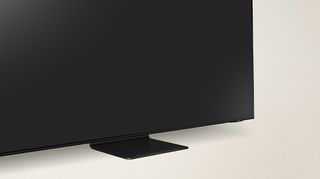
Samsung QN90A QLED TV: design
- Minimal bezel and made with premium materials
- Pedestal stand is a bit wobbly
- Eco-friendly, solar-powered remote works well
From a sheer aesthetic standpoint, there’s nothing to dislike about the Samsung QN90A. It has a beautiful look with premium materials and looks great both wall mounted and on its stand. In terms of design, however, the stand is a bit dicey.
When we had the TV fully set up on the stand, with screws fastened as tight as possible, there was still a reasonable amount of wobble to the TV. It wasn’t as bad as the Sony X950H that we lambasted last year for its shakiness, but it’s still much less stable than we’d like. Of course, we can only speak about the 65-inch version of the TV that we had in for testing – the 55-inch TV might be totally fine with its lower weight and center of gravity.
One of the reasons the QN90A is a bit more unstable this year is because it’s a bit thinner. Compared to last year, Samsung shaved about half an inch from the depth from the TV which has meant making some compromises on sound quality and stability. That’s not a bad thing if you plan on connecting the TV to an external sound system – like one of Samsung’s Dolby Atmos soundbars – and wall-mounting the TV, but it’s all worth noting.
The other issue with the Samsung QN90A’s design is that it only comes with one full-bandwidth HDMI 2.1 port. That could be a slight problem down the road, but the good news is that, for now, all four ports can handle both the PS5 and Xbox Series X at 4K/120Hz, VRR and ALLM. Despite all four ports working well for the consoles, port 3 is the only port to support eARC, so you’ll want to use that for a soundbar.
Unfortunately, all of these ports are located directly on the back of the TV and not on Samsung’s OneConnect box, which is only available with the QN95A, Q800A and Q900A models. The QN90A does have a way to hide wires by tucking them into the grooves of the back of the TV – but it’s not as elegant of a solution as the OneConnect box is.
What is an elegant solution, however, is the new eco-friendly remote that runs off a solar-powered battery. It works right out of the package, and then re-charges every night by sitting on the edge of the window sill. By the time we wanted to watch TV again in the mid-morning or early afternoon, the remote was fully charged again.
Besides being easy to charge, the remote uses Bluetooth, which means it works without line-of-sight to the TV, and it comes with a built-in microphone that can be used to query smart assistants. Overall, it’s still quite solid despite being one of the smaller mainstream TV remotes and the eco-friendliness of it definitely wins it some points in our book.
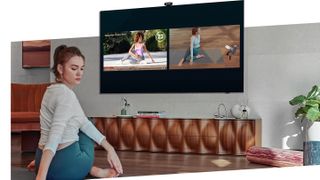
Samsung QN90A QLED TV: smart TV (Tizen)
- Supports multiple built-in assistants
- Large app library with some apps supporting HDR10+
- Screen casting and Apple AirPlay 2 support, too
Underpinning the Samsung QN90A is the Tizen smart platform that Samsung has been using for, well, what feels like forever. New this year is the ability to change which smart assistant the TV uses and your options include Alexa, Google Assistant and Bixby. We still don’t think Bixby is on par with the other two, but now that’s less of an issue given the fact that it’s easy to switch to one of the others instead.
As for the UI of Tizen, it’s a pretty clean look. Pressing the home button brings up an overlay along the bottom of the screen with your frequently used apps and sources as well as the settings and Ambient Mode. Ambient Mode, more or less, is a lower power mode that helps the TV blend into its surrounding environment while retaining some key information – like the time – up on the screen. It’s been around for a few years now and is still an interior decorator’s dream come true.
The other neat built-in feature for Tizen is Samsung’s proprietary Samsung TV Plus app that blends traditional TV channels with streaming channels for a more robust – and free – app experience. Best of all, Samsung TV Plus looks similar to a lot of cable guides, which means browsing for something to watch is relatively intuitive and you can pick from a number of popular networks like ABC News, MTV, Nickolodeon and more. These channels are all ad-supported, so you’ll see an ad every once in a while, but otherwise it’s a boon for Tizen.
In terms of app support, all the main streaming platforms are there including Netflix, Amazon Prime Video, Disney Plus and Hulu. To download any apps that don’t come built into the TV requires you to sign in using a Samsung account – which is admittedly a bit of a pain – and some apps look better than others. Amazon Prime Video, for example, with its HDR10+ support certainly looks better than HBO Max that, when we tried streaming Mortal Kombat, inexplicably defaulted to the fit-to-screen picture setting and couldn’t be changed. In the end we had to use another streaming device instead, which was a bit of a bummer.
Speaking of UI overlays, it’s also worth talking a bit more about the Game Bar and GameView features of Tizen. While they certainly can be helpful for console gamers as they confirm the refresh rate of the TV, they’re much more helpful for PC gamers. For example, connecting the QN90A to a PC allows you to control the aspect ratio, however you will need to manually adjust the output of the PC for 21:9 (3840x1600 or (2560x1080) or 32:9 (3840x1080). Some gamers will prefer this format while others will be five with 16:9, but having the option does make a strong case for using the Samsung QN90A as a monitor.
To end on a positive note, the TV does support screen casting for most major apps and Apple AirPlay 2. Sharing content to the screen is relatively easy and extremely convenient – plus, if you use a Samsung smartphone or smart watch, you can sync your biometric data to the TV using the built-in Samsung Health app. It’s not worth tossing out your iOS device for if you aren’t already on Samsung’s Android platforms, but it’s a nice perk for those of us who are.

Samsung QN90A QLED TV: picture quality
- Mini LED enhances peak brightness and color saturation
- Neo Quantum Processor 4K does a great job upscaling
- Some motion issues, but can be tweaked in picture settings
Of course, a TV of this caliber is all about picture performance and it’s here that the QN90A really delivers the goods. To wit, most content looks truly jaw-dropping on the QN90A – it’s brighter and more colorful than most other 4K TVs, and thanks to the use of Mini LED, it has better black levels and contrast than other LED-LCD TVs.
To understand why that’s the case, however, we have to peel back the layers of the TV and talk about how the Mini LED backlighting system interacts with the QLED technology. The former, as you might know, adds thousands more LEDs to the backlight compared to traditional LED-LCD screens. Those are divided into more zones and those zones can then be better controlled, resulting in better black levels and contrast. When those Mini LED zones are engaged, they can output higher brightness levels than traditional LED arrays and when you combine the higher peak brightness with the additional range of colors provided by the quantum dot filter of QLED, you’ve got better color saturation and more vibrant images.
That said, the capability to produce brighter, more color-saturated images is one thing – but knowing when and where to employ that technology is a whole different matter. That’s where the Neo Quantum Processor 4K takes over. Using 16 neural networks, the Neo Quantum Processor 4K analyzes images on a frame-by-frame basis, upscaling the image if it’s coming from a sub-4K resolution using an image database and boosting contrast and color saturation.
How much color and contrast can be tweaked by any one of the five picture setting modes. Standard tones down colors and brightness for a more natural picture that will look good in most living rooms, while Dynamic mode is a good fit for rooms with an abundance of natural light. Movie mode adds an almost sepia-like tone to the content, while Film Maker mode turns off motion processing completely for a more cinematic experience. All the modes have their pros and cons, but we found each to be enjoyable in their own way.
But speaking of motion processing, it’s worth talking about the new Motion Xcelerator Turbo+ technology that’s used by the Neo Quantum Processor 4K. It’s slightly more judicious in the way it uses judder reduction, but stutter is still an issue because of the way the TV’s native 120Hz refresh rate. Basically, the TV can overprocess some images, giving films a soap opera effect or, worse, making some scenes that have a bit of a natural shaky cam effect look like something from the Blair Witch Project or Cloverfield – it’s non-stop shaking that can really be a turn off.
The good news is that you can actually go in and tweak the judder and stutter individually through Samsung’s picture settings and we highly recommend doing so.
But what does actual content look like? Games like Returnal on PS5 look amazing, with tear-free motion and very little input latency (sub-10ms) while most 4K HDR movies and shows looked exceptionally good, too. It’s a bit of a disappointment that Samsung still refuses to support Dolby Vision content – but its support of HDR10+ means that shows like Jack Ryan on Amazon Prime Video remain stand-out showcases for Samsung TVs.
Would it be better if the Samsung QN90A used self-emissive technology like the purported QLED-OLED we’ve heard so much about? Sure. There is still a small amount of blooming and issues with grey uniformity (most commonly known as the ‘dirty screen’ effect) but there does seem to be some real improvement in these areas year on year.
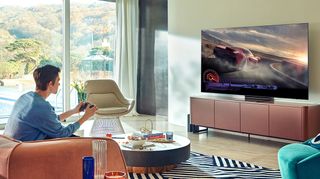
Samsung QN90A QLED TV: sound performance
- Sound quality is hit-or-miss
- Uses OTS+ instead of OTS+ Pro
- Plan on buying a soundbar for maximum enjoyment
The Samsung QN90A’s sound quality is, well, surprisingly mediocre and feels like a real step back from previous models. Unless you really crank the volume up past half-way (50+), the bass response is barely audible and the highs simply don’t shimmer. Even the mid-range, the focus of most TV shows and movies, can sometimes be hard to make out.
Part of the problem here might be that the Samsung QN90A uses Object Tracking Sound Plus with a max output of 60W instead of the 70W OTS+ Pro setup that the Samsung QN800A and Samsing QN900A have. The 10W isn't a huge deal-breaker and it’s better than the 10W speaker systems on other TVs certainly, but it’s a real step down compared to the upper-tier models and even the UK-exclusive Samsung QN95A and the 8K Neo QLED TVs.
To put it through its paces, we tried a number of different tracks – movies, TV shows and even some music and games – and the results were largely the same: anemic bass, alright vocals that could be hard to make out at some points (see: Mortal Kombat on HBO Max) and a lack of details in the upper frequencies.
Some songs sounded better than others, admittedly, and the Spotify app could get significantly louder than most shows, but the Samsung QN90A didn’t have a large soundstage or convincing holography. That’s severely disappointing as one of the highly touted new features of the Neo Quantum Processor 4K is AI Sound that promises a 3D audio-like experience.
Thankfully, Samsung does let you tweak the sound through an EQ if you leave it on the Standard sound mode, however that option will be disabled if you have AI Sound turned on. If you don’t want to use AI and you don’t want to fiddle with the EQ, you can use the Amplify setting to get an uplift in mids at low volumes, which does help alleviate some problems.
All that said, you’ll probably want to invest in a soundbar to get the best sound to go with the picture. Should you decide to go with one of Samsung’s soundbars – like the Samsung HW-Q950T – you’ll be able to use the TV’s speakers in tandem with the soundbar for more powerful sound and that’s probably your best option when picking up a QN90A.
Should you buy the Samsung QN90A Neo QLED TV?
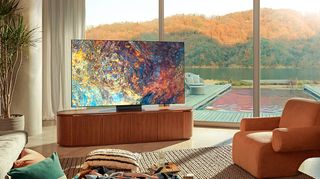
Buy it if…
You want the brightest, most color-rich 4K HDR TV
You can’t knock the Samsung QN90A for its brightness. It routinely hits over 1,000 nits with HDR content and can reach upwards of 2,000 nits with the right content. Colors look rich and vibrant, and black levels look pretty nice as well for a QLED TV.
You’re buying a next-gen console (or two)
Although it doesn’t have four full-spec HDMI 2.1 ports, Xbox Series X runs at 4K/120Hz on all four ports. That means you won’t have to worry about which port gets which console, and can rest easy knowing that this TV will work with both next-gen systems.
You’re tied into Samsung’s ecosystem of products
It’s not a deal breaker if you don’t have a Samsung smartphone or smart watch, but it does make things a bit easier if you’re already a part of Samsung’s ecosystem of products should you choose to buy the QN90A. You’ll need a Samsung account to download more apps from the Samsung store, however, and should you choose to enable it, the TV can sync health data with your Samsung devices if you want to keep tabs on your biometrics throughout the day.
Don’t buy it if…
You’re planning on putting it on a low stand that can easily be tipped over
With an extremely high center of gravity, the 65-inch version of the TV could easily be toppled if enough force is applied. To that end, we’d highly recommend wall-mounting it, if possible, or at the very least putting it out of reach of any children or animals.
You don’t plan on buying a soundbar to go with it
Sound performance is a mixed bag on the Samsung QN90A. Sometimes shows and movies sound great, sometimes they don’t. Sometimes music sounds good, but most of the time it’s still lacking bass impact and overall clarity. The solution? You’ll probably want to buy a soundbar to go with this TV.
You want perfect black levels and uniformity
Until we get that QLED-OLED hybrid we’ve been hearing so much about, it’s impossible to get perfect black levels and screen uniformity from an LED-LCD TV – even one as accomplished as the Samsung QN90A. If you’re after the best black levels – and are willing to risk potential burn in issues – then an OLED might be a better fit for you.
First reviewed April 2021.
Nick Pino is Managing Editor, TV and AV for TechRadar's sister site, Tom's Guide. Previously, he was the Senior Editor of Home Entertainment at TechRadar, covering TVs, headphones, speakers, video games, VR and streaming devices. He's also written for GamesRadar+, Official Xbox Magazine, PC Gamer and other outlets over the last decade, and he has a degree in computer science he's not using if anyone wants it.
